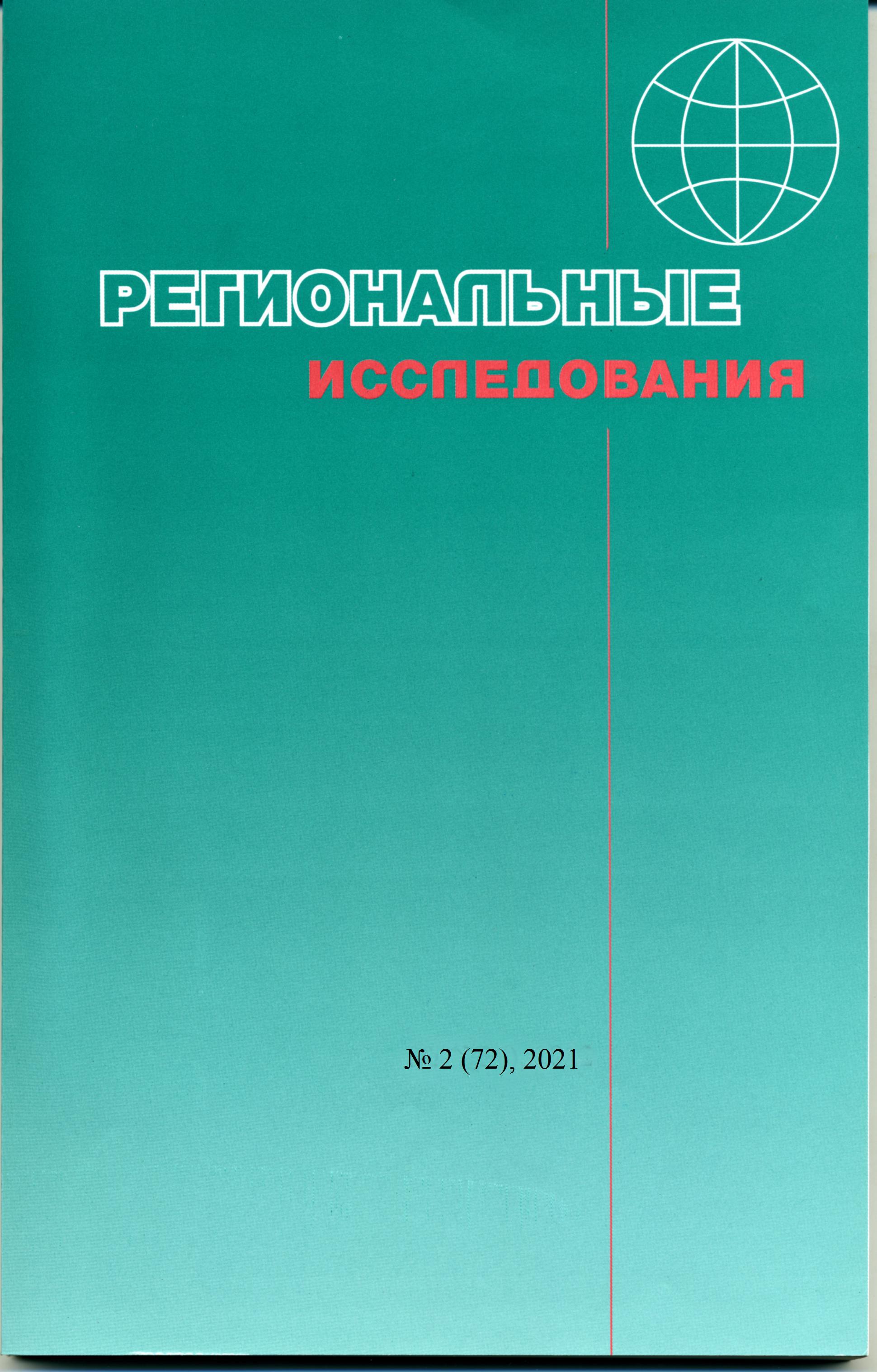Smooth A.C. Multiscale approach to investigating the spatial heterogeneity of the income distribution of the Brazilian population
DOI:
https://doi.org/10.5922/1994-5280-2021-2-10Keywords:
regional inequality, multi-scale approach, modifiable areal unit problem, geographical generalization index, income distribution, BrazilAbstract
The aim of the research is to identify the key features of spatial inequality of income distribution in Brazil and its representation on different spatial scales: on the regional, state or municipal level, as well as special statistical grids (mesoregions and microregions). The economic development of Brazil in the beginning of the XXI century is characterized by reducing of the level of income inequality, as well as a certain decrease of the level of spatial inequality between the southern and northeastern regions. The common rule is that the heterogeneity of income distribution gradually increases from top to the lower levels of spatial division. The analysis of inequality measures has proven that despite of the general decrease of regional inequality in 2000–2010, the lower levels of territorial division have shown the lowest progress in reducing regional inequality. The paper also proposes the ways to illustrate spatial inequality when applying polyscale method, based on mapping the variation of average population income in Brazil on different scale levels.
References
Антонов Е.В. Территориальная концентрация экономики и населения в странах Европейского союза и в России и роль глобальных городов // Региональные исследования. 2019. № 3 (65). С. 26–41.
Баранский Н.Н. Избранные труды. Научные принципы географии. М.: Мысль, 1980. 239 с.
Гладкий А.С. Оценка соответствия метрополитенских ареалов в Бразилии критериям трудовых взаимосвязей // Вестн. Моск. ун-та. Сер. 5. Геогр. 2018. № 2. C. 78–84.
Григорьев Л. М. Социальное неравенство в мире – интерпретация неочевидных тенденций // Журнал Новой экон. ассоциации. 2016. № 3 (31). С. 160–170.
Зубаревич Н.В., Сафронов С.Г. Неравенство социально-экономического развития регионов и городов России 2000-х годов: рост или снижение? // Обществ.науки и современность. 2013.№ 6. С. 15–26.
Коломак Е.А. Неравномерное пространственное развитие в России: объяснения новой экономической географии // Вопросы экономики. 2013. № 2. С. 132–150.
Овчарова Л.Н., Попова Д.О., Рудберг А.М. Декомпозиция факторов неравенства доходов в современной России // Журнал Новой экон. ассоциации. 2016. № 3 (31). С. 170–186.
Самсонов Т.Е., Юрова Н.Д. Применение картограмм и картодиаграмм на мультимасштабных социально-экономических картах // Геодезия и картография. 2014. № 11. С. 30–38.
Трейвиш А.И. Географическая полимасштабность развития России: город, район, страна и мир: дисс. … докт. геогр. наук: 25.00.24 / Ин-т географии РАН. М., 2006. 309 с.
Шевчук Е.И., Кириллов П.Л., Петросян А.Н. Проблема генерализации данных в исследованиях пространственной неоднородности социально-экономических явлений на разных масштабных уровнях // Региональные исследования. 2019. № 3 (65). С. 4–15.
Almeida E. Econometria espacial aplicada. Campinas: Editora Alínea, 2012. 498 p.
Araújo J.A. Economic growth and income concentration and their effects on poverty in Brazil // CEPAL review. 2017. Vol. 123, № 4. P. 34–53.
Barros R.P., Carvalho M., Franco S., Mendona R. Determinantes da queda da desigualdade de renda Brasileira. Texto para Discussão № 1460. Rio de Janeiro, 2010. 50 p.
Beirão É.S., Barbosa E.V.P., Esdras Leite M. Desigualdade na distribuição de renda nos municípios do estado de Minas Gerais // Acta Scientiarum. Human and Social Sciences. 2019. Vol. 41, № 2. P. 1–11.
Bessa D.C., Ferreira C.R. Decomposição das Parcelas de Rendimento Domiciliar per capita para o Brasil e Região Nordeste, de 1995 a 2011 // VIII SOBER Nordeste. Parnaíba. 2013. 19 p.
Bourguignon F. The growth elasticity of poverty reduction: explaining heterogeneity across countries and time periods // Inequality and Growth: Theory and Policy Implications. Eicher T. and Turnovsky S., eds. The MIT Press, 2007. P. 3–26.
Brambilla M.A., Marconato M., Nascimento S.P. Análise espacial do nível de desenvolvimento dos municípios do estado do Paraná // Revista Economia & Região. Londrina. 2015. Vol. 3, № 1. P. 81–102.
Elbers C., Lanjouw J., Lanjouw P. Micro-level estimation of poverty and inequality // Econométrica. 2003. Vol. 71, № 1. P. 355–364.
Gaulard M. Balance sobre la cuestión de las desigualdades en Brasil // Problemas del desarrollo. 2011. Vol. 42, № 166. P. 111–134.
Krugman P. R., Venables A.J. Globalization and the Inequality of Nations // The Quarterly Journal of Economics. 1995. Vol. 110, № 4. P. 857–880.
Kuznets S. Economic growth and income inequality // American Economic Review. 1953. Vol. 45, № 1. P. 1–28.
Marques E., Torres H. São Paulo. Segregação, pobreza e desigualdades sociais. São Paulo: Editora do Senac, 2005, 324 p.
Milanovic B. True World Income Distribution, 1988 and 1993: First Calculation Based on Household Surveys Alone // World Bank Policy Research Working Paper № 2244. November 1999. 40 p.
Milanovic B. Worlds Apart. Measuring International and Global Inequality. Princeton: Princeton University Press, 2005. 240 p.
Neves C., Rondina Neto A., Esteves E.G.Z., Parré J.L., Amaral A.E., Câmara M.R.G. Concentração de renda nos Municípios da Região Sul entre 2000 e 2010: Análise geográfica temporal utilizando a abordagem exploratória de dados espaciais // Espacios. 2015. Vol. 36, № 23. P. 6.
Novotny J. On the measurement of regional inequality: does spatial dimension of income inequality matter? // Annals of Regional Science. 2007. Vol. 41, № 3. P. 563–580.
Openshaw S. The modifiable areal unit problem. Concepts and techniques in modern geography. Norvich: GeoBooks, 1984. 86 p.
Shorrocks A, Wan G. Spatial decomposition of inequality // Journal of Economic Geography, 2005, vol. 5, no. 1, pp. 59–81.
Theil H. Statistical decomposition analysis. Amsterdam: North Holland, 1972. 337 p.
Instituto Brasileiro de Geografia e Estatística [Электр. ресурс]. URL: http://www.ibge.gov.br (дата обращения: 15.04.2020).

